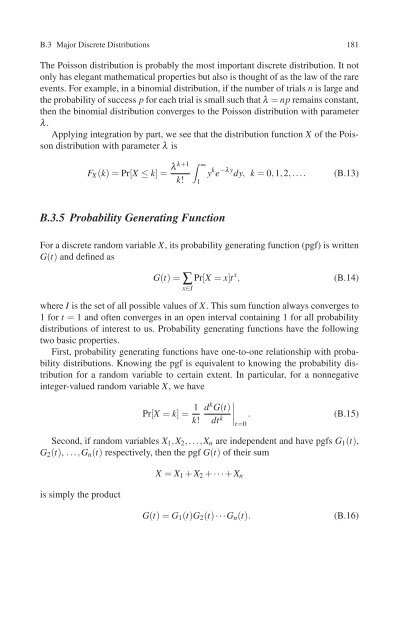Create successful ePaper yourself
Turn your PDF publications into a flip-book with our unique Google optimized e-Paper software.
B.3 Major Discrete Distributions 181<br />
The Poisson distribution is probably the most important discrete distribution. It not<br />
only has elegant mathematical properties but also is thought of as the law of the rare<br />
events. For example, in a binomial distribution, if the number of trials n is large and<br />
the probability of success p for each trial is small such that λ = np remains constant,<br />
then the binomial distribution converges to the Poisson distribution with parameter<br />
λ.<br />
Applying integration by part, we see that the distribution function X of the Poisson<br />
distribution with parameter λ is<br />
F X (k)=Pr[X ≤ k]= λ k+1<br />
k!<br />
∫ ∞<br />
1<br />
y k e −λy dy, k = 0,1,2,....<br />
(B.13)<br />
B.3.5 Probability Generating Function<br />
For a discrete random variable X, its probability generating function (pgf) is written<br />
G(t) and defined as<br />
G(t)=∑ Pr[X = x]t x ,<br />
x∈I<br />
(B.14)<br />
where I is the set of all possible values of X. This sum function always converges to<br />
1fort = 1 and often converges in an open interval containing 1 for all probability<br />
distributions of interest to us. Probability generating functions have the following<br />
two basic properties.<br />
First, probability generating functions have one-to-one relationship with probability<br />
distributions. Knowing the pgf is equivalent to knowing the probability distribution<br />
for a random variable to certain extent. In particular, for a nonnegative<br />
integer-valued random variable X, wehave<br />
Pr[X = k]= 1 k!<br />
d k G(t)<br />
dt k ∣<br />
∣∣∣t=0<br />
. (B.15)<br />
Second, if random variables X 1 ,X 2 ,...,X n are independent and have pgfs G 1 (t),<br />
G 2 (t), ...,G n (t) respectively, then the pgf G(t) of their sum<br />
is simply the product<br />
X = X 1 + X 2 + ···+ X n<br />
G(t)=G 1 (t)G 2 (t)···G n (t).<br />
(B.16)

















